Winter months on conservation sites can seem long and harsh– especially at a site that is exposed to high winds that whip around the configuration of hills around it. At Llwyn Celyn, it feels like the same wind hits you twice (at least) and is all the more cruel for it. It would therefore seem like a strange time to strip the stone tiles off a roof, and begin the steady, careful work of repairing the roof timbers. Luckily a sturdy tin hat has been de rigueur at Llwyn Celyn for many years.
Llwyn Celyn has been surrounded by scaffolding and sheeting for at least a decade - wrapped up like a sugar cube, sheltered from the elements. This protective layer was put over the building in the early 1990s, when CADW realised that the roof was leaking and was in need of urgent repair. It was supposed to be a temporary solution, so when we came to the site some 20 years later in April 2016, we had to strengthen and reconfigure the scaffolding to make it safe to work upon. Then, we had to wait for the resident bats to leave the building, which had become their summer home, before we could start work on the roof.
Finally, last November, the first tiles were guided down wooden slides and carefully stacked up ready to be reused. As the tiles were removed, the old roof timbers were exposed and, relieved of their weight, could be properly assessed to see if they could be repaired or would need to be replaced.
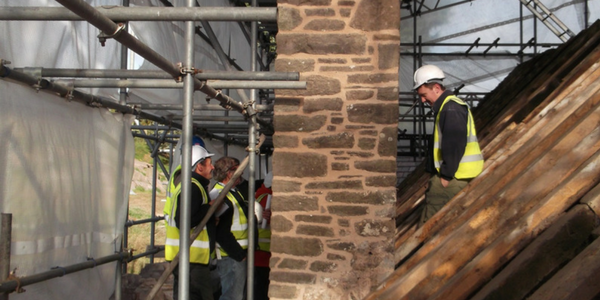
The project team assessing the condition of the exposed roof.
The roof over the medieval house is in two parts – one double pitch over the solar and one over the hall. The join between these two roofs forms a valley. Roof details like these are difficult to make watertight and the valley at Llwyn Celyn had, not surprisingly, been leaking for decades. The result was a lot of rotten timber. Elsewhere we had to meticulously survey each member of the roof structure, marking up each purlin and rafter. Their condition was recorded on a drawing, which was later used by the carpenters as they worked their way through a long list of repairs.
Some of the major work included the repair of an arch brace, which had sheared away. The sheared section was strapped up and slowly guided, under great tension back into place. Where principal rafters had weakened, our structural engineer devised a canny solution – hiding steel bracing in the top side of the rafter, thus saving the original timbers.
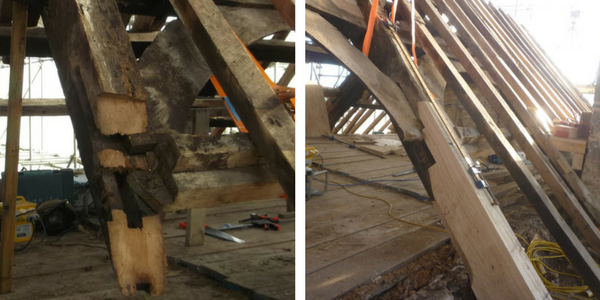 Before and after: this particularly complex repair resulted in a stop splayed scarf joint with under squinted square abutment. As much of the original fabric has been preserved.
Before and after: this particularly complex repair resulted in a stop splayed scarf joint with under squinted square abutment. As much of the original fabric has been preserved.
The wall plate, where the top of the stone wall and roof meet, has been repaired and repointed. During this process we discovered two old shoes, which had been hidden as good luck charms to ward off evil spirits – a common practice in rural homes.
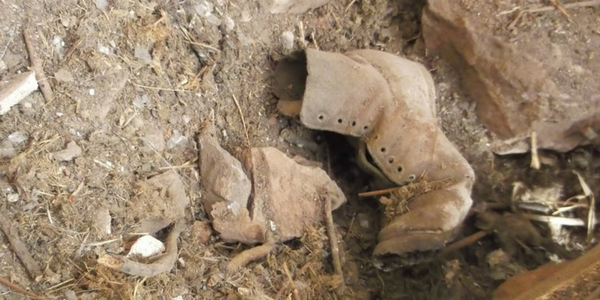 One of the shoes discovered hidden in the building.
One of the shoes discovered hidden in the building.
With the roof off, the interior of the building has been flooded with winter light, making work to the internal spaces much easier. We have removed partitions, opened up windows, and importantly explored (and debated) the evolution of the house from open medieval hall to a ceiled space with private rooms and chambers. This physical change to the building is not just a reflection of changing fashions, but of an evolution in the way we live. Life had once been a communal experience, but later in the 17th century social order and separation of master and servant began to change where people slept and ate and with whom they shared their time.
Buildings evolved to reflect and reinforce these shifts, developments clearly seen at Llwyn Celyn. The role of our Philosophy of Repair is to consider which point in time to take the building back to in our presentation of it. Although we have discovered details that postdate our agreed period of core significance in the mid-17th century, happily nothing has emerged so far to undermine the validity of that philosophy.
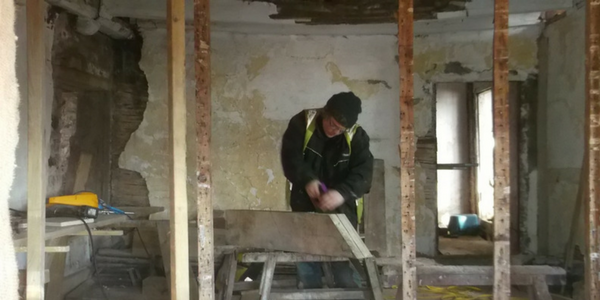 A carpenter working in the first floor of the Solar, where we are removing later partitions.
A carpenter working in the first floor of the Solar, where we are removing later partitions.
As far as elements go, wind is not the only factor that the building has to contend with. Water is a constant feature of the hillside setting. In medieval times you built near a spring and Llwyn Celyn is well endowed with both spring water, that bubbles up and out from around the footings of the building, and surface water which shifts its way downhill moving earth and debris with it. The house is no barrier to this water - when it rains, the ground floor rooms become a pool.
Over time walls have shifted where water and earth has accumulated. We have temporarily lifted the stone floors (to eventually enable the installation of underfloor heating) and have installed drains to capture and divert water safely out of the building. More work to the immediate, external landscape to manage this will happen this year.
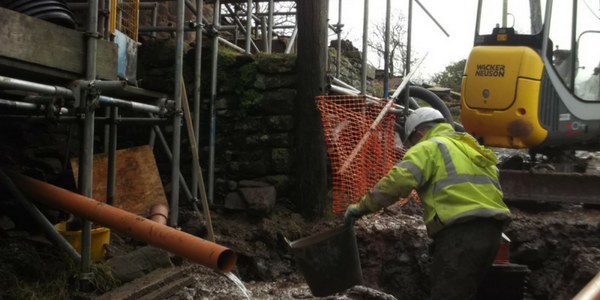 Water flows out from an internal pipe whilst a contractor prepares the main drain.
Water flows out from an internal pipe whilst a contractor prepares the main drain.
As spring now starts to spread through the valley, the roof tiles are nearly all back on the building, together with an insulating layer of sheep’s wool, and we can at last begin to peel away the protective sheeting and scaffolding. For many who have moved to the valley in the last decade or so, this will be the first time they will see the building without its cover. Llwyn Celyn will once again sit with pride at the mouth of the Llanthony Valley and be a welcome sight for travellers en-route to the priory, and for locals going about their daily life.